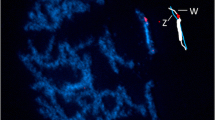Abstract
Satellite DNA from the mealworm beetle,Tenebrio obscurus, is composed of 344 bp long monomers of high AT content (68%), and represents 15% of the total DNA.In situ hybridization reveals the positions of the satellite on the pericentromeric heterochromatin of allT. obscurus chromosomes. To compare restriction enzyme (RE) effects with those on naked DNA, fixed chromosomes were digested with REs having recognition sites in most of the satellite monomers, and also with enzymes having target sites present only partially, or very rarely in the satellite units. All enzymes produce similar C-like banding patterns showing heterochromatin resistance to digestion regardless of the enzyme used.In situ nick translation suggests the inability of REs to cleave satellite DNA rather than the inefficient extraction of DNA fragments. DNA in heterochromatin was only extensively digested when the chromosomes were preincubated with proteinase K, indicating that accessibility of REs to DNA is increased by the removal of chromosomal proteins. This is in contrast to recently obtained results inTenebrio molitor, where cleavage of satellite DNA is equally efficient in both fixed chromosomes and in naked DNA. The satellite DNAs of the two congeneric species differ in their AT content, and their primary and higher order structure, which could influence both heterochromatin structure and the accessibility of REs to satellite DNA.
Similar content being viewed by others
References
Adolph S (1988)In situ nick translation distinguishes between Cband positive regions on mouse chromosomes.Chromosoma 96: 102–106.
Bianchi N, Vidal-Rioja L, Cleaver JE (1986) Direct visualization of the sites of DNA methylation in human and mosquito chromosomes.Chromosoma 94: 362–366.
Bullerdiek J, Dittmer J, Faehre A, Barnitzke S, Kasche V, Schloot W (1985) A new banding pattern of human chromosomes byin situ nick translation usingEcoRI and biotin d-UTP.Clin Genet 28: 173–176.
Bullerdiek J, Dittmer J, Faehre A, Barnitzke S (1986) Mechanism ofin situ nick translation of chromosomes using restriction endonucleases.Cytobios 47: 33–44.
Burkholder GD (1989) Morphological and biochemical effects of endonucleases on isolated mammalian chromosomesin vitro.Chromosoma 97: 347–355.
Davis CA, Wyatt GR (1989) Distribution and sequence homogeneity of an abundant satellite DNA in the beetle,Tenebrio molitor.Nucleic Acids Res 17: 5579–5586.
de la Torre J, Mitchell AR, Sumner AT (1991) Restriction endonuclease/nick translation of fixed mouse chromosomes: a study of factors affecting digestion of chromosomal DNAin situ.Chromosoma 100: 203–211.
Gosalvez J, Lopez-Fernandez C, Ferrucci L, Mezzanotte R (1989) DNA base sequence is not the only factor accounting for restriction endonuclease activity on metaphase chromosomes: evidence using isochisomeres.Cytogenet Cell Genet 50: 142–144.
Juan C, Gosalvez J, Petitpierre E (1990) Improving beetle karyotype analysis: restriction endonuclease banding ofTenebrio molitor fixed chromosomes.Heredity 65: 157–162.
Juan C, Gosalvez J, Mezzanotte R, Petitpierre E (1991) Cytological and biochemical characterization of thein situ endonuclease digestion of fixedTenebrio molitor chromosomes.Chromosoma 100: 432–438.
Lopez-Fernandez C, Gosalvez J, Ferrucci L, Mezzanotte R (1991) Restriction endonucleases in the study of eukaryotic chromosomes.Genetica 83: 257–274.
Lozano R, Sentis C, Fernandez-Piqueras J, Ruiz Rejon M (1991)In situ digestion of satellite DNA ofScilla siberica.Chromosoma 100: 439–442.
Mezzanotte R (1986) The selective digestion of polytene and mitotic chromosomes ofDrosophila melanogaster byAluI andHaeIII restriction endonucleases.Chromosoma 93: 249–255.
Mezzanotte R, Ferrucci L, Vanni R, Bianchi U (1983) Selective digestion of human metaphase chromosomes byAluI restriction endonuclease.J Histochem Cytochem 31: 553–556.
Mezzanotte R, Rossino R, Nieddu M, Lopez-Fernandez C, Gosalvez J (1992) The DNA fragments produced byAluI andBstNI digestion of fixed mouse chromosomes.Chromosoma 101: 641–644.
Miller A, Choi Y, Miller O (1983) Chromosome localization of highly repetitive human DNAs and amplified ribosomal DNA with restriction enzymes.Science 219: 395–397.
Petitpierre E, Gatewood JM, Schmid CW (1988) Satellite DNA from the beetleTenebrio molitor.Experientia 44: 498–499.
Pinkel D, Gray J, Trask B, van den Engh G, Fuscoe J, van Dekken H (1986) Cytogenetic analysis byin situ hybridization with fluorescently labeled nucleic acids probes.Cold Spring Harbor Symp Quant Biol 51: 151–157.
Plohl M, Borštnik B, Ugarković D, Gamulin V (1990) Sequenceinduced curvature ofTenebrio molitor satellite DNA.Biochimie 72: 665–670.
Radic MZ, Saghbini M, Elton TS, Reeves R, Hamkalo BA (1992) Hoechst 33258, distamycin A, and high mobility group protein I (HMG-I) compete for binding to mouse satellite DNA.Chromosoma 101: 602–608.
Sambrook J, Fritsch EF, Maniatis T (1989)Molecular cloning. A laboratory manual. Cold Spring Harbor, USA: Cold Spring Harbor Laboratory.
Sanger F, Niclen S, Coulson AR (1977) DNA sequencing with chain-terminating inhibitors.Proc Natl Acad Sci USA 74: 5463–5467.
Strauss F, Varshavsky A (1984) A protein binds to a satellite DNA repeat at three specific sites that would be brought into mutual proximity by DNA folding in the nucleosome.Cell 37: 889–901.
Sumner AT (1972) A simple technique for demonstrating centromeric heterochromatin.Exp Cell Res 75: 304–306.
Sumner AT (1990)Chromosome Banding, London: Unwin Hyman, pp. 259–271.
Sumner AT, Taggart MH, Mezzanotte R, Ferrucci L (1990) Patterns of digestion of human chromosomes by restriction endonucleases demonstrated byin situ nick translation.Histochem J 22: 639–652.
Ugarković D, Plohl M, Gamulin V (1989) Sequence variability of satellite DNA from the mealwormTenebrio molitor.Gene 83: 181–183.
Author information
Authors and Affiliations
Corresponding author
Rights and permissions
About this article
Cite this article
Ugarković, D., Plohl, M., Petitpierre, E. et al. Tenebrio obscurus satellite DNA is resistant to cleavage by restriction endonucleasesin situ . Chromosome Res 2, 217–223 (1994). https://doi.org/10.1007/BF01553322
Received:
Revised:
Accepted:
Issue Date:
DOI: https://doi.org/10.1007/BF01553322




